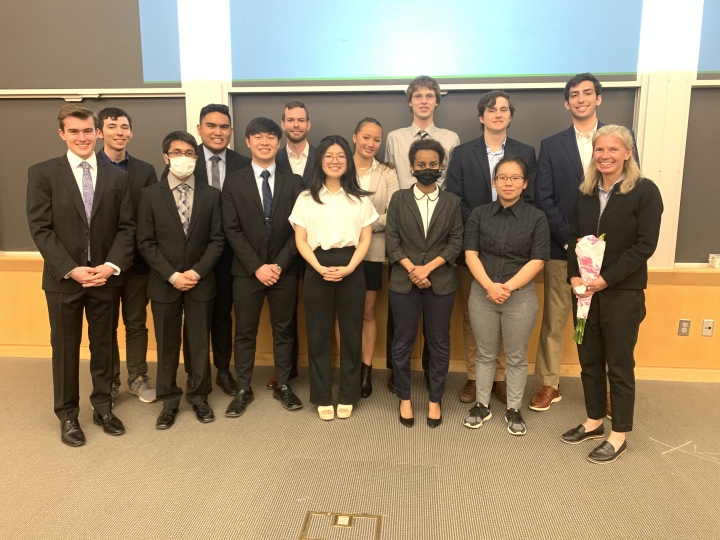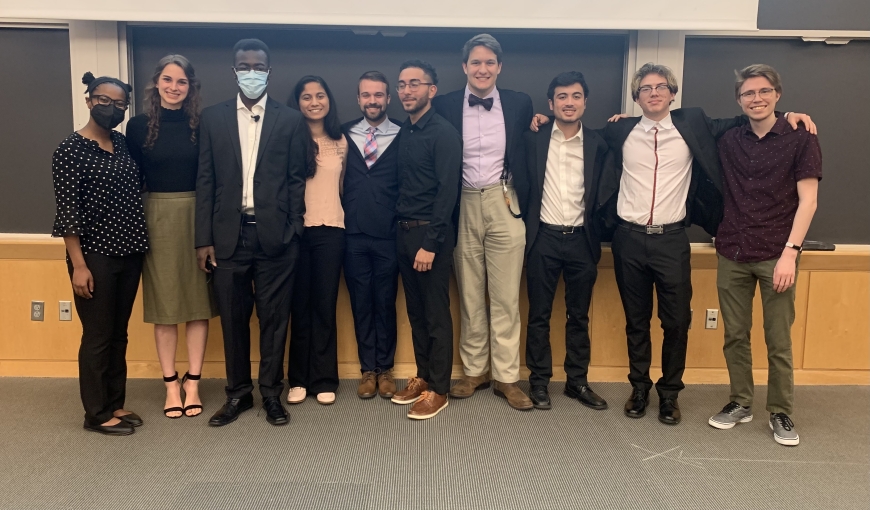News
If a computer program is improperly coded, it won’t work. If a rocket is incorrectly assembled, it won’t launch. If a drug delivery system fails to deliver its medication, the patient’s symptoms won’t improve.
But sometimes engineers face large, open-ended challenges that have no easy or obvious solutions. Two groups of students at the Harvard John A. Paulson School of Engineering and Applied Sciences (SEAS) faced a challenge like that in their section of ES96: Engineering Problem Solving and Design Project, a core course for the S.B. degree in Engineering.
This group of ES96 students developed new surveys and a wiki for internal operations and communications for Breaktime, which works to end young adult homelessness. Top row from left are teaching fellow Daniel Hasegawa, Joshua Ng, Julian Hopf, Corinne Lee, Adam McMullin, Jack Goodwin and Jason Martel. Bottom row: Brendan Devine, Umar Padela, Eugene Veloso, Tran Nguyen, Saba Zerefa, Joy Lin and instructor Kelly Miller. (Matt Goisman/SEAS)
The students worked with Boston-based startup Breaktime, which offers educational, employment and financial opportunities to help young adults experiencing homelessness to transition to stable housing.
“Breaktime's initial challenge for the students was to identify gaps and challenges they saw in our programming, our operational infrastructure, and the way our team functioned,” said Connor Schoen (A.B. ’21, Applied Math), Breaktime co-founder and executive director. “We left this challenge relatively open-ended because a big part of the learning objectives of this course is to coach students on how to identify specific problems in the first place.”
Each of the two groups eventually identified two different challenges, focusing on something that could be of value to Breaktime and make a difference for homeless people (the associates). One group focused on demographic data collection and streamlining internal communication and processes, while the other focused on training program retention for both associates (those undergoing training) and coaches.
ES96 teaches students how to define large-scale engineering challenges, mapping out all the different stakeholders and systems interwoven into the task at hand. By analyzing the complexity of a social challenge such as homelessness, they were then positioned to define a solution that could potentially be undertaken within a one-semester course.
“Most of the semester was spent just formulating our idea for the problem,” said Brendan Devine, a member of the data collection team. “We spent 80 percent of the time figuring out what the problem was, and then the next 20 percent actually coming up with our solution. Consulting with people who were experts in the space, looking at all the various options and paths we could go down, that was really the crux of the problem we spent the majority of our time on.”
To address data collection and internal processes, the first section created a survey for coaches to use with their associates during training meetings. Survey topics included food stability, current housing situations, and financial well-being-- all potential indicators of whether the associate was successfully transitioning out of homelessness.
Survey results collected in an online wiki page would be the home for internal documents such as grant applications and operations.
“Every time we did something here, we did it with the intention of helping people,” said Jason Martel, who worked on the wiki. “It just made every class feel worth it.”
This section of ES96 added formal breaks and more coaching resources to the training program at Breaktime, which works to eliminate young adult homelessness. From left are Bianca Byfield, Ariann Sanford, Richard Amankwaa, Fouzia Raza, Jaxson Hill, David Andrade, Cloud Barre, Quan Narula, Dakota Passage and Joseph Bilski. (Matt Goisman/SEAS)
To improve associate and coach retention, the second group worked on two modifications to the Breaktime training program. The first, named “Refuel,” allows associates to take formalized breaks during the first two stages of the program, which take approximately 17 weeks to complete. By requiring scheduled communications with associates and offering a financial incentive to stay with the program, associates would be able to pause their training without fully dropping out.
“You want to improve the basics of your program level and value proposition, and then expand that out, streamline and make it more efficient,” said Fouzia Raza, who worked on Refuel. “We decided that focusing on the program itself in the long run would help them get more grants and stakeholders.”
For coach retention, students created the “Gravity Assist,” which is a compilation of strategies from former coaches, opportunities for incoming coaches to shadow current ones before officially starting, and resources to address challenges outside of Breaktime’s control, such as housing instability.
“I’m pretty proud of what we came up with,” said Bianca Byfield, who worked on Gravity Assist. “I think our ideas were pretty fleshed out, and I’m glad that we were able to explore them throughout our time. Obviously, if this was longer, we would’ve been able to go more in depth and see how it implements in Breaktime’s program.“
Breaktime’s co-founders, Schoen and Tony Shu, both have ties to Harvard and SEAS. Shu, A.B. ‘21, was part of the Undergraduate Technology Innovation Fellows program, run jointly by SEAS, Harvard Business School, and the Faculty of Arts & Sciences.
“We are appreciative of how deeply the students analyzed the challenges we laid out, and we are inspired by their passion and dedication throughout the semester,” Schoen said. “We are working to implement several of the students' recommendations across all of the initial challenges we identified.”
The survey and wiki team consisted of Devine, Martel, Jack Goodwin, Corinne Lee, Joy Lin, Adam McMullin, Joshua Ng, Tran Nguyen, Umar Padela, Eugene Veloso, Julian Hopf and Saba Zerefa. The Refuel/Gravity Assist team consisted of Byfield, Raza, Richard Amankwaa, David Andrade, Cloud Barre, Joseph Bilski, Jaxson Hill, Quan Le Narula, Dakota Passage and Ariann Sanford. Kelly Miller, Federico Capasso and Fawwaz Habbal were the instructors for the two sections.
“The soft skills that we’re building in this course, such as divergent thinking, communicating with outside organizations and having to be tactful, and the team-building within sections, I really crave those experiences because those are the things that I thrive on,” Hopf said. “I think those are also the make-or-break factors for most projects, so I think it’s been a great class.”
Topics: Academics, Computer Science
Cutting-edge science delivered direct to your inbox.
Join the Harvard SEAS mailing list.
Press Contact
Matt Goisman | mgoisman@g.harvard.edu




